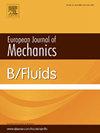结构参数对流体振荡器性能的影响
IF 2.5
3区 工程技术
Q2 MECHANICS
引用次数: 0
摘要
流体振荡器依靠科恩达效应,是一种可以在空间和时间上改变射流方向或速度的流量控制装置。与直接喷射喷嘴相比,基于流体振荡器的燃料喷射装置可显著提高雾化和空间分散性能。然而,当在以航空煤油为工作介质的高热负荷后燃烧器中使用时,可能会出现氧化结焦问题。为解决这一问题,建议使用预混合富燃料蒸汽作为工作流体,以减少燃料在振荡器中的停留时间。本研究探讨了理想空气(模拟气相燃料)在通过具有不同厚度和出口喉管宽度的双反馈通道流体振荡器时的流速和频率变化。研究采用了实验和数值模拟方法。通过研究流体振荡器腔内的流场结构,分析了影响机理。结果表明,增加流体振荡器的厚度会导致更高的出口切向速度和偏转角,同时降低振荡频率。相反,加宽流体振荡器的喉部会导致切向速度、偏转角和振荡频率降低。当出口喉部为正方形时,流体振荡器的性能达到临界值。随着厚度的增加,振荡频率的下降速度和切向速度的上升速度都会减慢。此外,振荡器出口处气流的最大偏转角在厚度为 3.375 毫米时达到临界值,超过该值后,偏转角的增加趋势也会减慢。当振荡器厚度小于 3.375 毫米时,质量流是混合室气流偏转的主要驱动因素。相反,当厚度大于或等于 3.375 毫米时,压力则成为偏转的主要驱动因素。本文章由计算机程序翻译,如有差异,请以英文原文为准。
Influence of structural parameters on the performance of fluid oscillators
The fluid oscillator, relying on the Coanda effect, is a flow control device that can alter the direction or velocity of a jet both spatially and temporally. The fuel injection device based on a fluid oscillator significantly enhances atomization and spatial dispersion performance compared to a direct-spray nozzle. However, when used in high heat load afterburners with aviation kerosene as the working medium, oxidative coking issues may arise. To address this, it is recommended to use premixed rich fuel-vapor as the working fluid in order to reduce the residence time of fuel in the oscillator. This study investigates the flow rate and frequency variation of ideal air (simulated gas phase fuel) as it moves through a double feedback channel fluid oscillator with varying thicknesses and outlet throat widths. Experimental and numerical simulation methods are employed. And the influence mechanism is analyzed through an examination of the flow field structure within the cavity of the fluid oscillator. The results indicate that increasing the thickness of the fluid oscillator leads to a higher outlet tangential velocity and deflection angle, while simultaneously decreasing the oscillation frequency. Conversely, widening the fluid oscillator throat results in a decrease in tangential velocity, deflection angle, and oscillation frequency. The performance of the fluid oscillator reaches a critical threshold when the outlet throat is square. As thickness increases, the rate of decrease in oscillation frequency and the rate of increase in tangential velocity both slow down. Furthermore, the maximum deflection angle of the airflow at the oscillator outlet reaches a critical value at a thickness of 3.375 mm, beyond which the trend of increasing deflection angle also slows. When the thickness of the oscillator is less than 3.375 mm, mass flow is the predominant driving factor for airflow deflection in the mixing chamber. In contrast, when the thickness is greater than or equal to 3.375 mm, pressure becomes the primary driving factor for this deflection.
求助全文
通过发布文献求助,成功后即可免费获取论文全文。
去求助
来源期刊
CiteScore
5.90
自引率
3.80%
发文量
127
审稿时长
58 days
期刊介绍:
The European Journal of Mechanics - B/Fluids publishes papers in all fields of fluid mechanics. Although investigations in well-established areas are within the scope of the journal, recent developments and innovative ideas are particularly welcome. Theoretical, computational and experimental papers are equally welcome. Mathematical methods, be they deterministic or stochastic, analytical or numerical, will be accepted provided they serve to clarify some identifiable problems in fluid mechanics, and provided the significance of results is explained. Similarly, experimental papers must add physical insight in to the understanding of fluid mechanics.

 求助内容:
求助内容: 应助结果提醒方式:
应助结果提醒方式:


